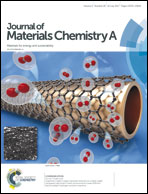Direct deposition of MoSe2 nanocrystals onto conducting substrates: towards ultra-efficient electrocatalysts for hydrogen evolution†
Abstract
There is an urgent need to develop efficient and cost-effective catalysts for the hydrogen evolution reaction (HER) in order to realize a hydrogen economy with clean and renewable energy. Nanostructures of layered transition metal dichalcogenides show promising electrocatalytic activity towards the hydrogen evolution reaction, however, the majority of the exposed surfaces (basal planes) are inactive, and engineering their catalytically active edge sites still remains a challenge. Here we show that monodisperse single/few-layered MoSe2 nanocrystals can be directly deposited onto any conducting substrate, through electrochemical exfoliation of bulk MoSe2, which exhibit remarkable electrocatalytic activity for the HER with ultra-high efficiency showing a very low on-set potential (70.9 mV vs. the RHE) and Tafel slope (31.8 mV dec−1). The exceptional electrocatalytic activity of the MoSe2 nanocrystals results from the synergistic advantages emerging from improved edge sites, enhanced electronic conductivity and the presence of new and active sites arising upon in situ lithiation, all in one step, which is facile, economic and environmentally benign.



 Please wait while we load your content...
Please wait while we load your content...